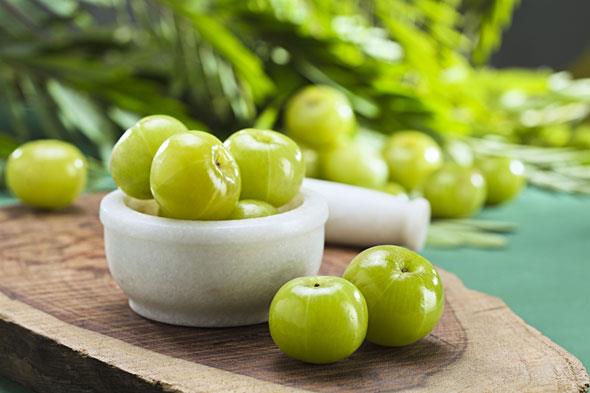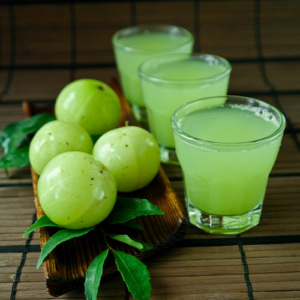The bitter Indian gooseberry for a healthy lifestyle
Amla or the Indian gooseberry, for its many benefits, has been used in Indian households since ages. While it is still enjoyed in some traditional recipes and flavours, culinary experiments are redefining how the green berry is consumed.
My memory of the berry takes me back to my childhood days, when feasting on an amla murabba (Indian gooseberry preserve) used to be a guilt-free pleasure.
Amla murabba is a traditional recipe wherein the bitter Indian gooseberry is dunked in a syrup of sugar, lime and water to preserve it and also to get rid of the bitter taste of amla. The only unhealthy thing about this recipe is the excessive sugar, as amla is actually a storehouse of good health, and so a favourite of mothers and grandmothers who preserve it and prepare it in various forms for their loved ones.
“Amla has been used in India for ages and primarily for its innumerable health benefits. It boosts metabolism, nourishes brain, improves skin and hair quality and strengthens urinary system. Apart from the health benefits, amla also has anti-ageing properties. In earlier days people used to add it to their bathing water,” says Shailendra Bhandari, executive chef, The Metropolitan Hotel & Spa in New Delhi . “It is also widely used in many Ayurvedic medicines like Mehar Choorna, Nishamalakai Choorna, etc.,” he adds.
Amla is rich in vitamin C, so much so, that a glass of its juice is about 20 times richer than a glass of orange juice. It is also rich in fibres, vitamin A, anti-oxidants and minerals such as chromium, zinc, copper, iron among others, making it a favourite of many nutritionists who include it in the diets they prescribe.
For one to consume amla, a fad diet is not required. It can simply be made part of one’s routine and consumed in various forms. Besides the traditional murabba, packaged amla candies (available in both sweet and spicy flavours) and amla juices now fill the shelves of many supermarkets. “Amla can also be taken dried or raw and it cures sore throat, painful mouth ulcers and helps in weight loss,” says Bhandari.
“Every morning I take my dose of amla by drinking 30 ml of the amla and loki (gourd) juice by Patanjali. I have been doing so for many years now and have seen improvement in my energy level amongst other benefits,” says Vaibhav Aggarwal, a marketing professional from Delhi.
Amla juice is one way people consume the berry, with both packaged and fresh juices being the option. “People are now commercialising on the benefits of amla by selling juices and the growing conscience of people regarding good health. I see vendors selling juices outside public parks to people who come there for their morning exercises and this business seems to be doing good,” says Aggarwal.
“Amla being an age old ingredient, many dishes and drinks have already been made from it. You can make pickles, murraba, jams, curries and even add it to daal (lentils) for a delicious taste. You can also make amla mocktails, amla-honey shot, amla-minty punch, amla and ginger drink and can be even more stylish and experimental with drinks. We have also introduced a healthy option to our menu called ‘bonda burger’ made from amla and aloe vera,” says Bhandari.
There are different varieties of amla available in India like Banarasi, Hathijhool and Chakaiya, Bhandari tells us.
Here are some benefits it can be eaten for:
1) Protein synthesis and better digestion- Fibres in amla help break down protein and thus also aid digestion.
2) Healing arthritis pain- Amla helps cure joint inflammation. The vitamin C works well for the pains.
3) Helping during pregnancy- Eating amla during pregnancy is considered good for both the mother and the child.
4) Reducing hair fall and works well for skin- While amla is widely consumed to remedy hair fall, its anti-oxidants and vitamins (vitamin A produces collagen, which makes the skin flexible) keeps skin nourished and free of marks.
5) Keeping a check on cholesterol levels- The minerals present in amla, particularly chromium, help prevent cardiovascular diseases. It also helps prevent type 2 diabetes. Hence those at the risk of diabetes should not eat the murabba and consume amla in another form.
6) Building better immunity- The dose of vitamin C helps build immunity too, while acting as a remedy for common ailments.
7) Helping ease menstrual cramps- Amla not only helps to ease menstrual cramps, it can also help one get rid of it, if taken regularly.
8) Keeping check on hemoglobin- Since amla is rich in iron, it helps manage anemia (lack of blood) and shoot the hemoglobin levels.











